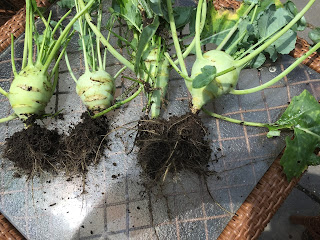What does scallions, green onions, spring onions and onions have in common? They are all part of the Allium (Latin for garlic) family along with garlic, leeks, shallots, chives etc. Allium are edible perennial plants. Although it is unclear how many species exist, the average is about 750 (250 on the low end to 900 on the high end). About a dozen are of importance to the gardener or farmer. Others are important for their ornamental value.
 |
To me, scallions are just underdeveloped onions, sort off. Very young onions are scallions in which the white root part has not developed into a bulb. Green or spring onions are slightly more rounded then scallions and are on their way to maturing into fully grown onions.
All can be eaten raw or cooked (leaves to root), however, there are differences in taste ranging from strong to week. Scallions are milder then onions, but stronger in flavor then chives. Green onions take on the flavor of their fully grown counterpart.
Never feed dogs or cats Alliums due to its potential for toxicity!







